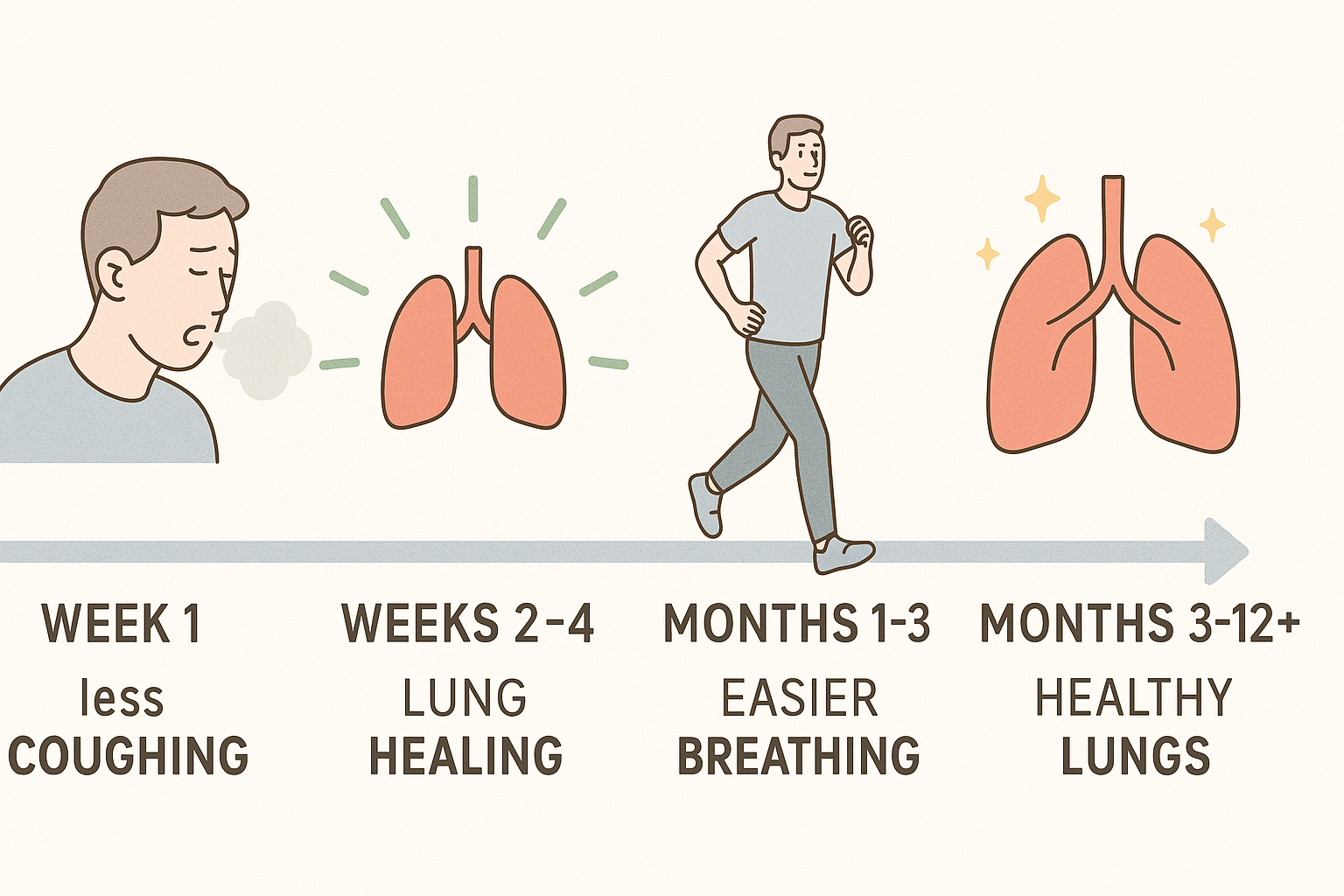If you find yourself wheezing or struggling to catch your breath after a simple walk, it’s easy to dismiss it as “just getting older.” But persistent wheezing is often your body’s signal that something more significant is happening in your respiratory system. Understanding the underlying causes can help you address the real issue rather than accepting discomfort as inevitable.
What Wheezing Actually Means
Wheezing is the high-pitched whistling sound that occurs when air moves through narrowed airways. It’s not just a normal part of aging—it’s a symptom that deserves attention.
“Many people assume that breathing difficulties are an inevitable consequence of getting older,” says Dr. Sarah Chen, a pulmonologist. “But when we investigate, we often find specific, treatable conditions that significantly improve quality of life.”
Common Causes of Exercise-Induced Wheezing
1. Exercise-Induced Bronchoconstriction (EIB)
Formerly known as exercise-induced asthma, EIB affects up to 90% of people with asthma and 10% of the general population.
How it works:
- Breathing faster and deeper during exercise cools and dries airway surfaces
- This triggers the release of inflammatory cells that narrow airways
- Symptoms typically begin 5-20 minutes after starting exercise
Key characteristics:
- Wheezing that starts during or immediately after activity
- Improves with rest
- May be worse in cold, dry air
2. Hidden Asthma
Many adults have undiagnosed asthma that only becomes apparent with physical exertion.
Red flags:
- Nighttime coughing or wheezing
- Symptoms triggered by allergens or cold air
- Family history of asthma or allergies
- Previous childhood respiratory issues
3. Early COPD (Chronic Obstructive Pulmonary Disease)
Often mistaken for aging, early COPD can manifest as exercise intolerance.
Risk factors:
- Smoking history (current or former)
- Long-term exposure to pollutants or dust
- Genetic predisposition (alpha-1 antitrypsin deficiency)
Early signs:
- Progressive shortness of breath with activities you used to handle easily
- Increased mucus production
- Frequent respiratory infections
4. Cardiac Issues
Your heart and lungs work as a team. Heart problems can manifest as breathing difficulties.
Warning signs:
- Wheezing that improves when sitting up
- Swelling in ankles or legs
- Chest pain or pressure
- Symptoms worse when lying flat
5. Vocal Cord Dysfunction (VCD)
Often misdiagnosed as asthma, VCD involves involuntary closure of vocal cords during inhalation.
Distinguishing features:
- Difficulty breathing IN (asthma typically affects breathing out)
- Sensation of throat tightness
- Symptoms may come on suddenly and resolve quickly
The Aging Factor: What’s Normal vs. Concerning
Normal Age-Related Changes
- Slight decrease in lung elasticity
- Gradual reduction in exercise capacity (about 10% per decade after 30)
- Mild shortness of breath with intense exertion
Concerning Symptoms Requiring Evaluation
- Progressive decline in walking distance
- Wheezing at rest or with minimal activity
- Blue-tinged lips or fingernails
- Unexplained weight loss with breathing difficulties
Diagnostic Steps: Finding the Root Cause
When to See a Doctor
Consult a healthcare provider if you experience:
- Wheezing that’s new or worsening
- Symptoms that interfere with daily activities
- Associated chest pain or dizziness
- No improvement with simple measures
Common Diagnostic Tests
- Spirometry: Measures how much and how quickly you can move air out of your lungs
- Chest X-ray: Rules out structural issues or infections
- Blood tests: Check for anemia, infection, or inflammation markers
- Allergy testing: Identifies potential triggers
- Echocardiogram: Evaluates heart function if cardiac issues are suspected
Immediate Relief Strategies
Breathing Techniques
- Pursed-lip breathing: Inhale through nose, exhale slowly through pursed lips
- Diaphragmatic breathing: Focus on expanding belly rather than chest
- Controlled recovery: Stop activity, sit upright, focus on slow, deep breaths
Environmental Adjustments
- Avoid extreme temperatures: Very cold or hot air can trigger symptoms
- Check air quality: Limit outdoor activity when pollution or pollen levels are high
- Use scarf in cold weather: Warming inhaled air can reduce bronchospasm
Quick-Action Supplements
While not replacements for medical treatment, some natural approaches may provide support:
- Breathe Drops: Contains mullein and thyme to soothe irritated airways
- Magnesium: Helps relax bronchial muscles (200-400mg before activity)
- Omega-3 fatty acids: Reduce exercise-induced inflammation
Long-Term Management Strategies
For Exercise-Induced Bronchoconstriction
- Pre-medication: Use prescribed inhalers 15-30 minutes before exercise
- Proper warm-up: 10-15 minutes of gradual activity can reduce symptoms
- Activity choice: Swimming in warm, moist air often better tolerated than running in cold air
For Undiagnosed Asthma
- Controller medications: Reduce airway inflammation when used regularly
- Trigger identification: Keep symptom diary to identify patterns
- Allergy management: Address underlying allergic triggers
For Early COPD
- Smoking cessation: Most critical intervention
- Pulmonary rehabilitation: Structured exercise and education program
- Vaccinations: Protect against respiratory infections
- Consider targeted lung support to aid recovery
For Cardiac-Related Symptoms
- Medical management: Address underlying heart conditions
- Fluid management: Monitor salt intake and weight
- Gradual activity progression: Under medical supervision
Building Exercise Tolerance Safely
The “Start Low, Go Slow” Approach
- Week 1-2: 10-15 minutes daily at comfortable pace
- Week 3-4: Increase to 20-30 minutes, add gentle hills
- Month 2-3: Incorporate interval training (walk 3 minutes, rest 1 minute)
Monitoring Your Progress
Keep an exercise journal tracking:
- Distance covered
- Wheezing severity (scale 1-10)
- Recovery time
- Medications or strategies used
- Environmental conditions
When to Push Through vs. When to Stop
Push through:
- Mild shortness of breath that resolves quickly with rest
- Moderate muscle fatigue
Stop immediately:
- Chest pain or pressure
- Dizziness or lightheadedness
- Severe wheezing that doesn’t improve with rest
- Blue-tinged lips or nails
Prevention: Building Resilient Airways
Lung-Healthy Lifestyle Habits
- Stay hydrated: Adequate fluid intake keeps mucus thin
- Practice good posture: Allows lungs to expand fully
- Maintain healthy weight: Reduces workload on respiratory system
- Avoid respiratory irritants: Smoking, strong chemicals, excessive dust
Respiratory Muscle Training
- Incentive spirometry: Deep breathing exercises with device
- Pursed-lip breathing practice: Even when not symptomatic
- Diaphragmatic strengthening: Lie with book on stomach, practice raising it with breath
Nutritional Support
- Antioxidant-rich foods: Berries, leafy greens, nuts combat oxidative stress
- Magnesium sources: Dark chocolate, nuts, seeds, legumes
- Omega-3 foods: Fatty fish, flaxseeds, walnuts reduce inflammation
When to Seek Emergency Care
Go to the emergency room if you experience:
- Severe shortness of breath that prevents speaking
- Rapid deterioration in breathing ability
- Chest pain accompanied by breathing difficulties
- Confusion or drowsiness from lack of oxygen
- No improvement after using rescue medications
Success Story: Regaining Activity Tolerance
Background: Michael, 58, had stopped his daily walks due to wheezing that he attributed to aging.
Diagnosis: After evaluation, he was diagnosed with exercise-induced bronchoconstriction and mild allergic asthma.
Treatment Plan:
- Pre-exercise albuterol inhaler
- Daily allergy medication
- Gradual walking program
- Environmental trigger avoidance
Results:
- Within 4 weeks: Walking 30 minutes without wheezing
- After 3 months: Added gentle hiking to his routine
- “I thought I was just getting old. Now I’m more active than I’ve been in years.”
✅ FAQ
1. Is wheezing after exercise always asthma?
No, while exercise-induced bronchoconstriction is common, wheezing can also indicate cardiac issues, vocal cord dysfunction, or other respiratory conditions. Proper diagnosis is essential for effective treatment.
2. Can wheezing be dangerous?
Mild, occasional wheezing with exercise may not be dangerous, but persistent or severe wheezing can indicate serious underlying conditions. Any new or worsening wheezing should be evaluated by a healthcare provider.
3. How can I tell if my wheezing is heart-related or lung-related?
Heart-related breathing difficulties often improve when sitting upright and may be accompanied by leg swelling or chest pressure. Lung-related issues typically involve cough or mucus production and may respond to bronchodilators. However, only proper testing can determine the cause.
4. Are there breathing exercises that can help with wheezing?
Yes, techniques like pursed-lip breathing and diaphragmatic breathing can help control wheezing episodes. These methods help keep airways open longer and improve oxygen exchange. Our breathing exercises guide covers these in detail.
5. Can allergies cause wheezing during exercise?
Absolutely. If you’re allergic to outdoor allergens like pollen, exercising outside can trigger wheezing. Similarly, indoor allergens like dust mites can be stirred up during activity. Identifying and managing allergies often improves exercise tolerance.
6. Should I avoid exercise if I wheeze?
Not necessarily. With proper management, most people with exercise-induced wheezing can remain active. The key is identifying the cause and developing an appropriate activity plan with your healthcare provider.
7. What’s the difference between wheezing and shortness of breath?
Wheezing is the audible whistling sound from narrowed airways, while shortness of breath is the sensation of not getting enough air. They often occur together but can happen independently.
8. Can acid reflux cause wheezing with exercise?
Yes, gastroesophageal reflux disease (GERD) can trigger wheezing, especially during exercise when abdominal pressure increases. If you have heartburn along with wheezing, discuss this possibility with your doctor.
9. Are there natural remedies that help with exercise-induced wheezing?
Some people find relief with caffeine (a mild bronchodilator), omega-3 supplements to reduce inflammation, or herbal lung support formulas. However, these should complement, not replace, medical treatment.
10. How long should I wait before seeing a doctor about exercise wheezing?
If wheezing occurs regularly with exercise and affects your activity level, schedule an appointment within a few weeks. If you experience severe symptoms like chest pain or inability to catch your breath, seek immediate medical attention.
“Which cause fits YOU? Take this 30-second quiz to uncover your personalized lung rescue plan.”
▶ Start the Quiz Now

Click on Image above to Take Quiz











